Belgrade Formation
The Belgrade Formation is a limestone geologic formation in North Carolina characterized by limestone coquina mixed with sand, and thinly laminated clays.[2] It preserves fossils dating back to the Paleogene period.
| Belgrade Formation | |
|---|---|
| Stratigraphic range: Oligocene-Miocene | |
| Type | Geological formation |
| Sub-units | Pollocksville Member, Haywood Landing Member |
| Overlies | River Bend Formation[1] |
| Lithology | |
| Primary | Limestone sand |
| Other | Clay |
| Location | |
| Region | |
| Country | |
| Type section | |
| Named for | Belgrade, North Carolina |
Description
The Belgrade Formation is composed of two subunits: the Pollocksville member and the Haywood Landing member. The Pollocksville member is composed of unconsolidated oyster shells and sand. It was deposited in the Oligocene and early Miocene. The Haywood Landing member is composed of shelly sands and thinly laminated clays. The Belgrade Formation was originally considered part of an Eocene formation called the Trent Marl before it was identified as being deposited in the Miocene and split off.[2]
Fossil content
Mammals
| Carnivorans | |||||
|---|---|---|---|---|---|
| Genus | Species | Presence | Material | Notes | Images |
| ?Amphictis | Jones County.[3] | A right mandible (NCSM 33670).[3] | An ailurid. | ||
| Cetaceans | |||||
|---|---|---|---|---|---|
| Genus | Species | Presence | Material | Notes | Images |
| Albertocetus | A. meffordorum | Isolated right petrosal (USNM 559392).[4][5] | A xenorophid. |  | |
| Ankylorhiza | A. tiedemani | CCNHM 6045 (a well preserved 10th lower postcanine).[5] | An odontocete. |  | |
| A. sp. | CCNHM 5554 (an isolated postcanine) and CCNHM 5465 (a partial bulla).[5] | An odontocete. | 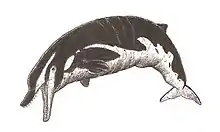 | ||
| Cotylocara | cf. C. sp. | CCNHM 4277 (a partial left bulla)".[5] | A xenorophid. |  | |
| Echovenator | E. sp. | A fragmentary petrosal.[4] | A xenorophid. | ||
| cf. E. | Partial tympanic bullae.[5] | A xenorophid, possibly the same taxon as Echovenator sp.[5] | |||
| Eomysticetidae | Eomysticetidae indet. | CCNHM 1831 and CCNHM 1821, both are right tympanic bullae.[5] | An indeterminate species most similar to (but sti differing from) Eomysticetus whitmorei. | ||
| cf. Eoplatanista | cf. E. sp. | "CCNHM 4276 (a partial right tympanic bulla)".[5] | |||
| Eurhinodelphinidae | Eurhinodelphinidae indet. | CCNHM 1828 (a partial right periotic) and CCNHM 4274 (a partial left tympanic bulla).[5] | "Compares favorably with Xiphiacetus cristatus and Eurhinodelphis cocheteuxi".[5] | ||
| ?Kentriodontidae | ?Kentriodontidae indet. | "CCNHM 4275 (a partial bulla)".[5] | |||
| Odontocete | Indeterminate | Belgrade Quarry.[4] | CCNHM 1903 (an isolated tooth).[5] | Indeterminate toothed whale remains, may represent a squalodelphinid or kentriodontid. | |
| cf. Physeteroidea | cf. Physeteroidea indet. | "CCNHM 1904 (a partial tooth)".[5] | May represent a juvenile physeteroid tooth. | ||
| Squalodelphinidae | Squalodelphinidae indet. | 3 right periotics and 3 right tympanic bullae.[5] | |||
| cf. Squalodon | cf. S. sp. | A periotic and multiple teeth.[5] | A squalodontid. | 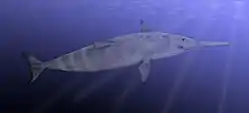 | |
| Waipatiidae | Waipatiidae indet. | "CCNHM 1354 (a posterior lower molar)".[5] | |||
| Xenorophidae | Xenorophidae indet. | "CCNHM 1833 (a partial right squamosal)".[5] | "Falls within the size range of Albertocetus, Echovenator, and Inermorostrum."[5] | ||
| Xenorophus | X. sp. | CCNHM 1826 (a partial postcanine) and CCNHM 1187 (a partial tympanic bulla).[5] | A xenorophid, may represent X. sloanii. | ||
| Sirenians | |||||
|---|---|---|---|---|---|
| Genus | Species | Presence | Material | Notes | Images |
| Crenatosiren | C. olseni | Onslow Beach.[5] | Skull caps.[5] | An early dugongid. | |
| Sirenia | Sirenia indet. | "CCNHM 1906 (a partial rib fragment)".[5] | "Approximately twice the diameter of ribs of Crenatosiren olseni, potentially representing a larger dugongid like Dioplotherium,
Stegosiren, or Priscosiren".[5] |
||
Reptiles
| Reptiles | |||||
|---|---|---|---|---|---|
| Genus | Species | Presence | Material | Notes | Images |
| Chelonioidea | Belgrade Quarry.[4] | Indeterminate sea turtle remains. | |||
| Crocodilia | Belgrade Quarry.[4] | Indeterminate crocodilian remains. | |||
Fish
Color key
|
Notes Uncertain or tentative taxa are in small text; |
| Chondrichthyes | |||||
|---|---|---|---|---|---|
| Genus | Species | Presence | Material | Notes | Images |
| Anoxypristis | A. sp. | Belgrade Quarry.[4] | A sawfish. | ||
| Carcharhinus | Belgrade Quarry.[4] | ||||
| Carcharias | C. sp. | Belgrade Quarry.[4] | A sand shark. | ||
| Carcharocles | C. angustidens | Belgrade Quarry.[4] | A megatooth shark, now reassigned to the genus Otodus. | ||
| Galeocerdo | G. casei or mayumbensis | Belgrade Quarry.[4] | A tiger shark. | ||
| Ginglymostoma | G. delfortriei | [6] | A nurse shark. | ||
| Hemipristis | H. serra | Belgrade Quarry.[4] | A snaggletooth shark. | 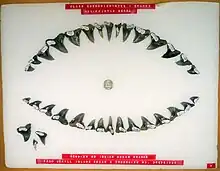 | |
| Myliobatis | M. sp. | Belgrade Quarry.[4] | An eagle ray. | 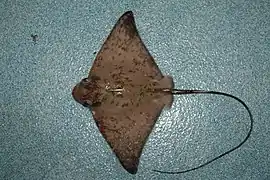 | |
| Nebrius or Ginglymostoma | Belgrade Quarry.[4] | A nurse shark. | |||
| Negaprion | Belgrade Quarry.[4] | A lemon shark. | .jpg.webp) | ||
| Notorynchus | N. primigenius | Belgrade Quarry.[4] | A cow shark. | ||
| Odontaspis | O. sp. | Belgrade Quarry.[4] | A sand shark. | ||
| Otodus | O. angustidens | Belgrade Quarry.[4] | A megatooth shark. |  | |
| Plinthicus | P. stenodon | Belgrade Quarry.[4] | An extinct ray. | ||
| Physogaleus | P. aduncas | Belgrade Quarry.[4] | A ground shark. | ||
| Rhinoptera | R. sp. | Belgrade Quarry.[4] | A cownose ray. | 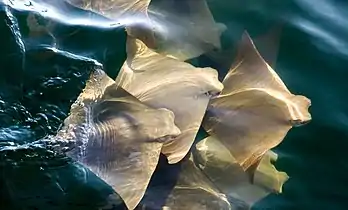 | |
| Squatina | S. sp. | Belgrade Quarry.[4] | An angelshark. | 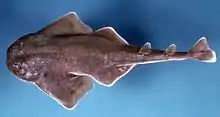 | |
| Osteichthyes | |||||
|---|---|---|---|---|---|
| Genus | Species | Presence | Material | Notes | Images |
| Lagodon | L. sp. | Belgrade Quarry.[4] | A pinfish. | 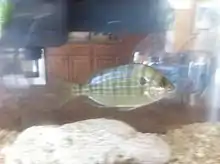 | |
Invertebrates
| Molluscs | |||||
|---|---|---|---|---|---|
| Genus | Species | Presence | Material | Notes | Images |
| Crassostrea | C. gigantissima | Upper finer grained unit, Pollocksville Member.[2][4] | An oyster. | ||
References
- Ward, L. W.; Lawrence, D. R.; Blackwelder, B. W. (1978). "Stratigraphic revision of the middle Eocene, Oligocene, and lower Miocene; Atlantic Coastal Plain of North Carolina". Bulletin. doi:10.3133/b1457F.
- Ward, Lauck W.; Lawrence, David R.; Blackwelder, Blake W. (1979). "Stratigraphic revision of the middle Eocene, Oligocene, and lower Miocene; Atlantic Coastal Plain of North Carolina" (PDF). U.S. Geological Survey Bulletin. 1457-F: 3–10. Retrieved 26 June 2018.
- Baskin, Jon; Dickinson, Edward; Hartstone-Rose, Adam (2020-07-08). "?Amphictis (Carnivora, Ailuridae) from the Belgrade Formation of North Carolina, USA". PeerJ. 8: e9284. doi:10.7287/peerj.9284v0.1/reviews/2. PMC 7353912. PMID 32714653.
- Boessenecker, Robert W.; Ahmed, Erum; Geisler, Jonathan H. (2017-11-08). "New records of the dolphin Albertocetus meffordorum (Odontoceti: Xenorophidae) from the lower Oligocene of South Carolina: Encephalization, sensory anatomy, postcranial morphology, and ontogeny of early odontocetes". PLOS ONE. 12 (11): e0186476. doi:10.1371/journal.pone.0186476. ISSN 1932-6203. PMC 5695589. PMID 29117197.
- Boessenecker, Robert W. (2022-09-03). "Oligocene-Miocene marine mammals from Belgrade Quarry, North Carolina". Geobios. 74: 1–19. doi:10.1016/j.geobios.2022.08.002. ISSN 0016-6995. S2CID 252077178.
- "Late Oligocene sharks and rays from the Chandler Bridge Formation, Dorchester County, South Carolina, USA - Acta Palaeontologica Polonica". www.app.pan.pl. Retrieved 2022-09-06.
- Various Contributors to the Paleobiology Database. "Fossilworks: Gateway to the Paleobiology Database". Retrieved 17 December 2021.
This article is issued from Wikipedia. The text is licensed under Creative Commons - Attribution - Sharealike. Additional terms may apply for the media files.